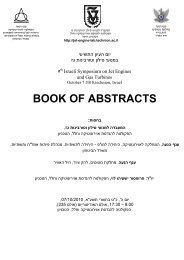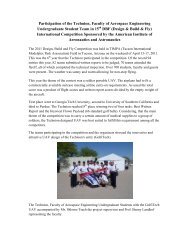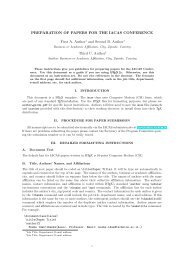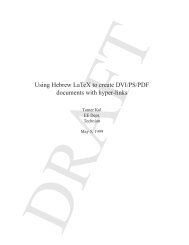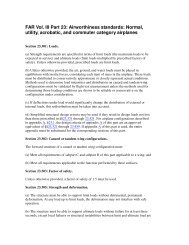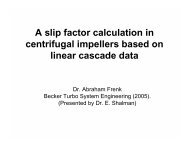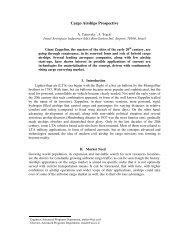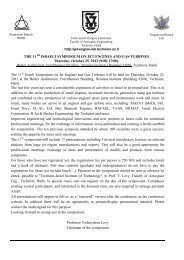A Century of Ramjet Propulsion Technology Evolution - Faculty of ...
A Century of Ramjet Propulsion Technology Evolution - Faculty of ...
A Century of Ramjet Propulsion Technology Evolution - Faculty of ...
You also want an ePaper? Increase the reach of your titles
YUMPU automatically turns print PDFs into web optimized ePapers that Google loves.
Australia 83 conducted, with international support, the world’s first<br />
verified demonstration <strong>of</strong> supersonic combustion in a flight environment<br />
under the HyShot flight program. The demonstration results<br />
have received international endorsement for achieving supersonic<br />
combustion conditions. Two flight tests were conducted: one unsuccessful<br />
flight in late 2001 and a second successful flight in mid-<br />
2002, where supersonic combustion was observed. The model was<br />
a heat-sink copper scramjet configuration that retained the essential<br />
components <strong>of</strong> supersonic combustion, which consists <strong>of</strong> an intake<br />
and two combustion chambers. The thrust surfaces were removed<br />
for simplicity. Thus, strictly speaking, the model is not a scramjet<br />
and, hence, closely related to the gun-launched ram-accelerator<br />
work being pursued by many. The intake (4 in. width) is a simple<br />
wedge <strong>of</strong> 17-deg half angle followed by parallel combustion<br />
chambers (0.4 × 3 in.). Whereas the Kholod tests obtained dualmode<br />
scramjet combustor data over a range <strong>of</strong> Mach number, the<br />
HyShot experiment obtained not only supersonic combustion data at<br />
a single Mach, but a wide range <strong>of</strong> dynamic pressures, which were<br />
compared to ground-test data obtained over the same range. The<br />
model was boosted into a highly parabolic trajectory by a two-stage<br />
Terrier-Orion Mk70 rocket. The spent motor and model payload<br />
fell back to Earth, gathering speed such that between 120,000 and<br />
75,000 ft altitudes they were traveling at approximately Mach 7.6.<br />
The program demonstrated that 1) an understanding <strong>of</strong> supersonic<br />
combustion gained from shock-tunnel ground tests is sufficient to<br />
design a simple supersonic combustor that will operate in flight and<br />
2) the test approach is a cost effective means to undertake hypersonic<br />
flight testing.<br />
Among the second generation flying testbeds currently explored<br />
by Russia is the use <strong>of</strong> a MIG-31 interceptor as a launch aircraft<br />
for exploring conditions from Mach 2 to 10 (Ref. 65). Unlike the<br />
axisymmetric Kholod, the study <strong>of</strong> two-dimensional hypersonic engines<br />
are more easily integrated into the body <strong>of</strong> an aircraft. Use<br />
<strong>of</strong> this aircraft seeks to overcome the shortcomings common to existing<br />
ground-based experimental facilities, which cannot provide a<br />
full simulation <strong>of</strong> all <strong>of</strong> the conditions <strong>of</strong> complex engine exposure<br />
to aerodynamic and heat loadings at speeds <strong>of</strong> Mach 6–8. This variant<br />
<strong>of</strong> flying laboratory allows research at conditions <strong>of</strong> Mach 2–10,<br />
altitudes <strong>of</strong> 50,000–130,000 ft, dynamic pressures <strong>of</strong> 1.4–30 lbf/in. 2 ,<br />
and an operational time for the scramjet <strong>of</strong> 40 s. The recoverable<br />
scramjet test module is air launched using a modified SA-10 solid<br />
propellant booster up to Mach 10 conditions in a ballistic trajectory.<br />
Test history revealed at the 1999 Moscow Air Show indicated<br />
100 min <strong>of</strong> direct-connect testing and 60 min <strong>of</strong> freejet testing.<br />
The U.S. Navy and DARPA initiated the HyFly (Fig. 39) program<br />
in early 2002 to mature and demonstrate, in-flight, DCR<br />
scramjet propulsion technology to enable hypersonic long-range<br />
missiles. 84 This four-year demonstrator project evolved from existing<br />
Navy hypersonic efforts and from DARPA’s ARRMD program.<br />
Direct-connect combustor testing begun in 2000 is continuing<br />
for Mach 3–6.5 and will continue for some time. Freejet tests at<br />
Mach 6–6.5 conditions were successfully completed in mid-2002<br />
<strong>of</strong> the JP-10-fueled, uncooled DCR engine fully integrated into a<br />
flight-representative aeroshroud or missile body. Future development<br />
will include additional direct-connect and wind-tunnel ground<br />
tests <strong>of</strong> the full-scale flight-weight engine into 2004. Subscale ballistic<br />
flights <strong>of</strong> the engine mounted on a sounding rocket are in progress<br />
with Mach 4 and Mach 6 cruise flight tests anticipated in 2004 and<br />
2005–2006, respectively. The Navy hypersonic propulsion developments<br />
are generally focused exclusively on missile applications,<br />
whereas the U.S. Air Force/NASA developments are aimed at both<br />
reusable platforms as well as one-time use vehicles.<br />
NASA initiated the integrated system test <strong>of</strong> an airbreathing<br />
rocket (ISTAR) program in 2002 with the objective to flight test a<br />
self-powered vehicle to more than Mach 6 by the end <strong>of</strong> the decade,<br />
which would demonstrate all modes <strong>of</strong> RBCC engine operation.<br />
Fig. 39 U.S. HyFly flight demonstration vehicle (2002–today).<br />
FRY 55<br />
The engine employs a hydrocarbon-fueled liquid rocket system for<br />
initial acceleration, with a ramjet that ignites at about Mach 2.5,<br />
followed by conversion to scramjet operation around Mach 5. The<br />
engine will have the capability <strong>of</strong> accelerating to Mach 7. The strutjet<br />
RBCC engine design was selected for ground demonstration and<br />
subsequent flight testing. Ground testing <strong>of</strong> a flight-weight, fuelcooled<br />
engine flowpath is scheduled to begin in 2006. The scramjet<br />
engine designs examined are expected to provide performance 15%<br />
above conventional rockets during the initial boost phases <strong>of</strong> the<br />
flight. Funding for the ISTAR flight test program was cancelled in<br />
late 2003, but ground testing is continuing.<br />
In 2002 the U.S. initiated X-43B as a follow-on development<br />
activity to X-43A Hyper-X. The program involves a flight demonstration<br />
<strong>of</strong> reusable RBCC or TBCC advanced vehicles in a notional<br />
10-min flight in the Mach 0.7–7 range. The RBCC engine<br />
was expected to be a strutjet, hydrocarbon-fueled and cooled design.<br />
The TBCC engine is expected to trace it roots to the HyTech<br />
and RTA technology bases. In late 2003 NASA decided to focus<br />
upon the TBCC flowpath for the X-43B and has renamed the effort<br />
the reusable combined cycle flight demonstrator (RCCFD). Flight<br />
testing is planned for the 2010 time frame.<br />
In 2003, France initiated LEA, a new flight-test demonstration <strong>of</strong><br />
a high-speed dual-mode ramjet propelled vehicle (Fig. 40) at flight<br />
conditions <strong>of</strong> Mach 4–8. The program is planned to demonstrate the<br />
feasibility <strong>of</strong> a positive aeropropulsive balance. 85 It will allow definition<br />
and flight validation <strong>of</strong> ground development methodologies for<br />
predicting aeropropulsive balance and required design margins. The<br />
final propulsion system used may be a fixed geometry (JAPHAR)<br />
or variable geometry (Promethée or PIAF). It is not planned to alter<br />
the geometry in-flight if a variable geometry design is selected.<br />
The expected flight consists <strong>of</strong> an aircraft release, acceleration <strong>of</strong><br />
the flight vehicle by a solid booster to the desired Mach number,<br />
booster separation, vehicle stabilization, and autonomous flight for<br />
20–30 s. Six flights are planned between 2010 and 2012. Semifreejet<br />
and freejet inlet testing activities are currently ongoing in support<br />
<strong>of</strong> the planned flight-test program. 86,87<br />
The technology developed by the United States in the HyTech<br />
program will next flow into two newly funded flight-test programs,<br />
the NASA–U.S. Air Force X-43C flight demonstration begun in<br />
1999 and the DOD SED begun in 2003. The SED (Fig. 41) program<br />
Fig. 40 France LEA concept flight test vehicle (2003–today).<br />
Fig. 41 U.S. endothermically fueled SED flight demonstrator (2003–<br />
2006).






